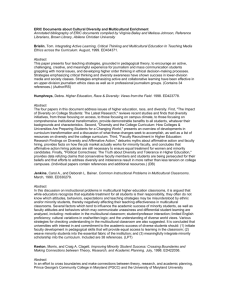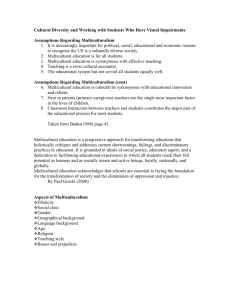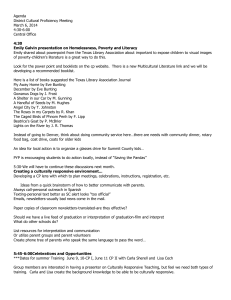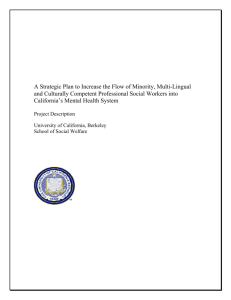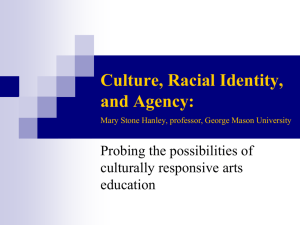fascdpresentation_re..
advertisement
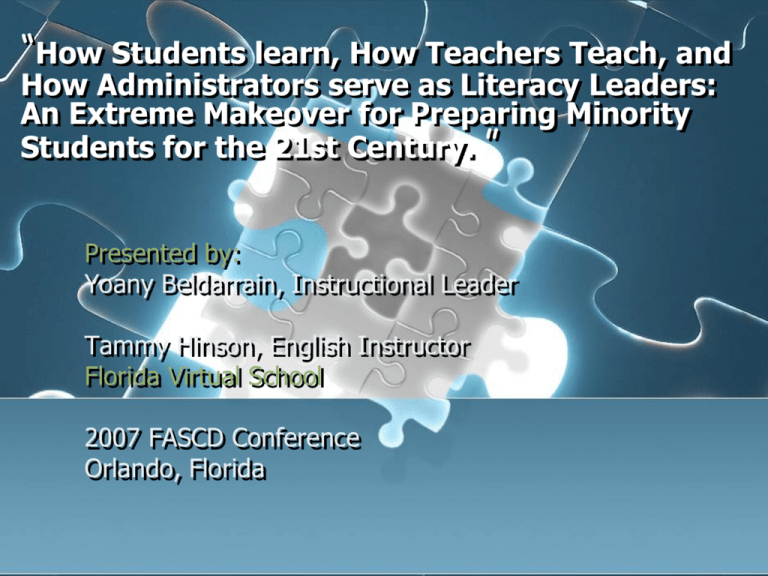
“How Students learn, How Teachers Teach, and How Administrators serve as Literacy Leaders: An Extreme Makeover for Preparing Minority Students for the 21st Century. ” Presented by: Yoany Beldarrain, Instructional Leader Tammy Hinson, English Instructor Florida Virtual School 2007 FASCD Conference Orlando, Florida Introduction If students were distributed evenly across the nations’ classrooms, every class of 30 students would include about 10 students from ethnic or racial minority groups. Of these 10, about 6 would be from language minority families (homes in which languages other than English are spoken); 2-4 of these students would have limited English proficiency (LEP), of whom 2 would be from immigrant families. Of the 6 language minority students in the class, 4 would speak Spanish as their native language, and 1 would speak an Asian language. The other language minority student would speak any one of more than a hundred languages. Of the 30 students in this hypothetical class, 10 (including nearly all of the language minority students) would be poor. The neighborhoods where poor children live are likely to be beset with multiple problems--inadequate health, social, and cultural services; insufficient employment opportunities; crime, drugs, and gang activity. Their families are likely to suffer the emotional stresses associated with poverty, and parents are likely to worry about their children's safety in a dangerous environment and about their future with few positive prospects. Overview- The Extreme Makeover… This presentation will provide a framework for providing reading instruction to minority students. Furthermore, it will provide strategies for teachers to use that will help these students think critically and function socially as they come of age and define their place in the 21st Century. In addition, participants will engage in hands-on activities that will help them to become more culturally responsive to the literacy needs of minority students and to help foster those academic and social identities that will allow them to develop a symphony of skills for living in the 21st Century. Objectives: Understand why we need to give special attention to the literacy of minority students. Use strategies for increasing the standardized test scores of minorities. Select text materials that empower and engage minorities. Understand what it means to be a “culturally responsive” teacher. Implement research-based literacy strategies that work with minorities. “Teacher InquIry” Culture Counts… Id, Ego, and Superego i am overwhelmed with inadequacies And i Fear inadequacy And i Suffer from the reality of inadequacy While i Deny inadequacy. Then i Cry inadequacy But i Buy inadequacy As it is pedaled by the meritocracy Who tell me i am inadequate, Poem taken from… And i believe. www.edchange.org/multicultural voices/p_2007id.html Culture Counts… REFLECTIONS… Using the poem as a guide, discuss these questions with the person sitting next to you… Is there a divide between in-school and out-of-school literacies of minority students? How early in life do you think minority students conclude that “traditional American education” is indifferent to their existence? VIDEO CLIP- Freedom Writers How does the clip from the movie reflect the meaning of the poem Id, Ego, and Superego? Culture Counts…. Alfred Tatum’s 4 C’s for creating a curriculum that fosters multiculturalism: Compassion Competence Commitment Cultural Responsiveness CAN YOUR CLASSROOM, YOUR SCHOOL, or YOUR DISTRICT EQUIP MINORITY STUDENTS FOR THE 21st CENTURY IN THE FACE OF NATIONAL LEGISLATION? The 4 C’s Brainstorm: Create a partnership with someone from another school or district and discuss with this person strategies that a teacher and an administrator could use to model culturally responsive pedagogy? Can your classroom, your school, or your district equip minority students for the 21st century in the face of national legislation? How Administrators serve as Literacy Leaders A newly defined role: 1. Instructional leadership 2. Coaching 3. Professional Development The Culture of Florida Virtual School: A Symphony of Skills Bringing out-of-school literacies in the classroom for students. Going beyond Skill and Strategy Instruction. Strengthening Concepts of Reading Teaching Students Responsibility Setting high expectations and supporting these expectations in a nurturing environment. Ongoing professional Development for Administrators, Teachers, and Staff Use of Cutting Edge Technology to prepare students and teachers for 21rst Century Learning Culturally Responsive Teachers… Know their students & the subject matter they teach. Place learning in a meaningful context. Help students understand more about themselves and about the world. Use literacy that is culturally relevant and speaks to their students’ experiences. Culturally Responsive Teachers… Help students understand society’s perception of who they are while helping students define who they want to become. Establish trusting relationships and feelings of kinship. Understand the lived experiences of their students and how their students respond to these experiences. Culturally Responsive Teachers… Connect, as best as they can, students’ in-school lives with their out-of-school lives. Understand their role as being broader than just helping students do well on tests. Understand cultural specific behaviors. Culturally Responsive Teachers… Plan instruction and assessment with a rich audit of who students are. Focus instruction on helping students develop strategies and hope for overcoming academic and societal barriers. Culturally Responsive Teachers… Culturally Responsive Teachers: Know their students and the subject matter they teach. Place Learning In a Meaningful Context. Help students understand more about themselves and more about the world. Use literature that is culturally relevant and that speaks to their students’ experiences. Help students understand society’s perception of who they are while helping students t define who they want to become. Establish trusting relationships and feelings of kinship. Understand the lived experiences of their students and how their students respond to these experiences. Connect, as best as they can, students’ in –school lives with their out-of-school lives. Understand their role as being broader than just helping students do well on tests. Understand cultural specific behaviors. Plan instruction and assessment with a rich audit of who the students are. Focus instruction on helping students develop strategies and hope for overcoming academic and societal barriers Always Sometimes Never Changing Expectations Shifting from remedial education to high standards and expectations for all…. Video Clip-Mona Lisa Smiles Discussion Topic: How does the teacher in this video clip change expectations and motivate her students to become more that what was expected of them? A Shift in Pedagogy… Video Clip “Akeelah & the Bee” A Shift in Pedagogy How did the teacher in this film change the traditional approach of instruction to help Akeelah define meaning for herself? How did Dr. Larabee build on and support Akeelah’s desire for success? Changing your Pedagogy… Teacher: How does my literacy instruction affect minority students in my class whose out-of-school literacies over power their in-school-literacies? Administrator: How do I support my teachers to ensure that they are placing learning in a meaningful context for all students? A Shift in Pedagogy FLVS NEHS hosts an online African American Read-In… Sponsors: D. Hernandez & M. Keller Guest readers and speakers from the business and academic communities over the USA share with students their favorite African American Writings and authors. Time periods covered range from Early Slavery to Modern Day. Meeting the Literacy Needs of Minority Students… Establish a broader definition of literacy instruction that guides the selection of course material. Discuss texts and topics in culturally responsive ways. Identify texts that balance the out-of-school literacy overload. Examine your disposition toward using multicultural texts and content with minority students. (Tatum, 2005) ~activity~ Tapping Into Students’ Funds of Knowledge Literacy must focus on skill and strategy knowledge, content knowledge, and identity development. (McGowan, 2005) A Model Lesson for Culturally Responsive Teaching… Learning is a social process, influenced by culture… Funds of Knowledge… “Students benefit when they can extend the ideas contained in texts into their own lives” (Tatum, 2005). Activity: Luther and “MY Man Blue” Funds of Knowledge After viewing Luther’s video “Dance with my Father” and listening to “My Man Blue”, how does Damon’s relationship with Blue differ from those relationships portrayed in Luther’s video? How is it the same? Compare and contrast your relationship with your father to that of either Damon & Blue or those portrayed in the video…or both. Changing Expectations Means Transforming Schools and Schooling… Student-Centered Pedagogy •The experiences of students must be brought to the fore in the classroom, making learning more active, interactive, and engaging. •Traditional teaching approaches and pedagogical models must be deconstructed to examine how they are contributing to and supporting institutional systems of oppression. •Known oppressive practices like tracking (even if informal) must be exposed and critically examined. Student-Centered Pedagogy All aspects of teaching and learning in schools must be refocused on, and rededicated to, the students themselves instead of standardized test scores and school rankings. Emphasis should be put on critical and creative thinking, and deep social awareness. They must be able to compete in a global marketplace. Student-Centered Pedagogy • Pedagogy must provide all students with equal potential to reach their potential as learners. • Pedagogy must be flexible enough to allow for the diversity of learning styles present in every classroom. Changing Expectations Means Transforming Schools and Schooling… Multicultural Curriculum •All curricula must be studied for accuracy and completeness. •All subjects must be told from diverse perspectives -- this is related to accuracy and completeness. •"Inclusive curriculum" also means including the voices of the students in the classroom. Multicultural Curriculum • • Concepts such as "the canon" and "classic literature" must be reconceptualized, again with the idea of accuracy and completeness, to debunk the perception that the only great literature came from the U.S. and England. Curricula should reflect the diversity of learning styles in every classroom. Changing Expectations Means Transforming Schools and Schooling… Inclusive Educational Media and Materials •Educational materials should be inclusive of diverse voices and perspectives. •Students must be encouraged to think critically about materials and media: Whose voice are they hearing? Whose voice are they not hearing? Why did that company produce that film? What is the bias this author may bring to her or his writing? 2000 American Anthropological Association. This information was cited in the December 2000 issue of Anthropology and Education Quarterly (31:4). Supportive School and Classroom Climate • Teachers must be better prepared to foster a positive classroom climate for ALL students. • Overall school cultures must be closely examined to determine how they might be cycling and supporting oppressive societal conditions. Supportive School and Classroom Climate Administrative hierarchies in schools must be examined to assess whether they produce positive teaching environments for all teachers. A Literacy Leader’s Perspective Supporting Teachers and Minority Students A Blueprint for Success. Establish, implement, and achieve academic standards that prepare students for the 21st Century. Be an instructional resource for your staff (get the curriculum needed to help the teacher reach these students. Write grants, seek donations from business partners, host school-wide fundraisers, etc.) Create a learning-oriented school culture and climate . Communicate your school’s vision and mission to staff and students in culturally responsive ways. Set high expectations for your staff and yourself. Develop teacher leaders (allow teachers to share their expertise and “what works” with their colleagues and teammates). Develop and maintain positive relationships with students, staff, and parents- Compassion leads to the motivation that fosters SUCCESS! Taken from: Seven Steps to Effective Instructional Leadership by Elaine K. McEwan Activity… Grandfather’s Journey By Allen Say Resources Gay, G. (1995). Bridging multicultural theory and practice. Multicultural Education, 3(1), 4-9. Lyons, C., and Pinnell, G.S. 200l. Systems for Change in Literacy Education: A Guide to Professional Development. Portsmouth, NH: Heinemann. Tatum, A. W. 2005. Teaching Reading to Black Adolescent Males: Closing the Achievement Gap. Portland, ME: Stenhouse. Parking Lot! Questions, Answers & Kudos… Contact Information: Yoany Beldarrain YBeldarrain@flvs.net Tammy Hinson THinson@flvs.net

